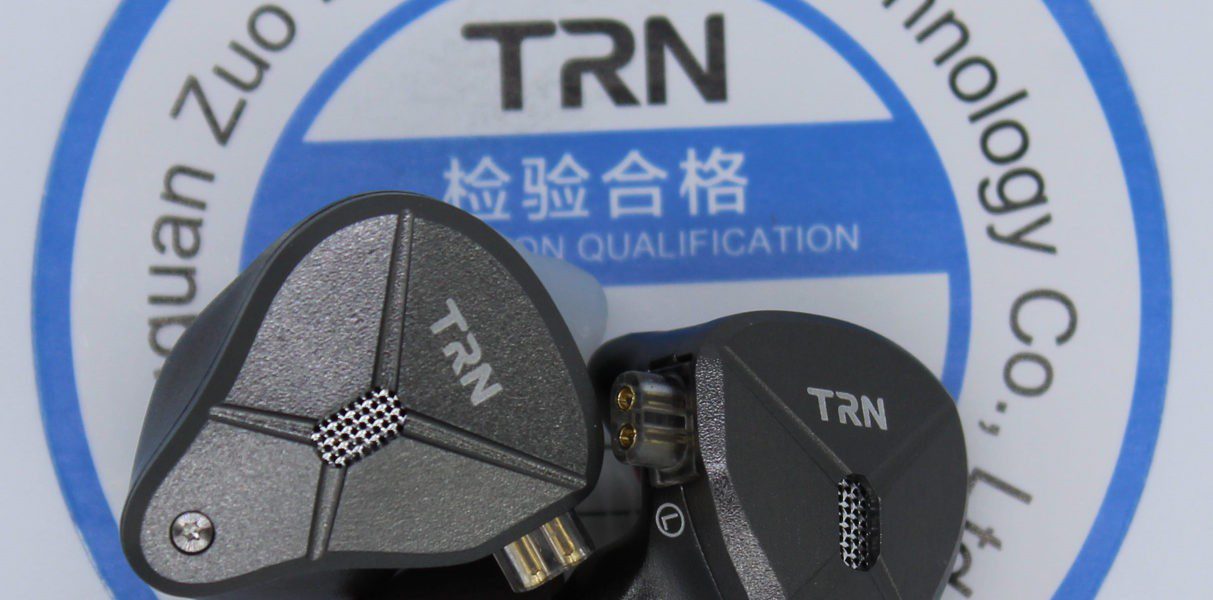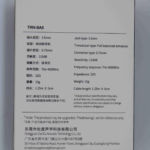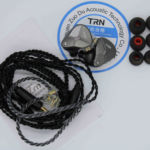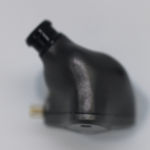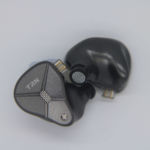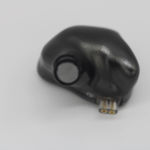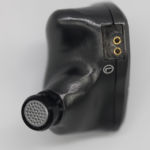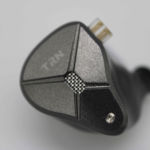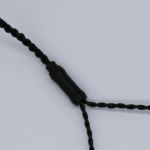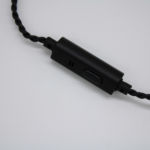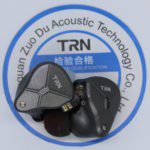TRN-BA5
disclaimer: I received a review sample of the TRN Ba5 from YooAudio. If you are interested in purchasing the Ba5 check YooAudio’s Amazon store. (hint, it makes good stocking stuffers)
Unboxing / Packaging:
Packing is the standard white box with the line drawing on the front and specs on the reverse. Inner packaging will be familiar as well as the earpieces sit in a foam tray with the manual, warranty card, tips, and cable hidden underneath. Tips are 3 sizes of silicone with the mid size being a slightly different style than the large or small. Overall, it is a kit we are used to from the budget conscious brands but with others in the $50 range stepping up their game, a case might have been appropriate to the mix.
Build/Fit:
The Ba5 is an aluminum shell and face-plate of medium size with a plastic nozzle and hooded bi-pin connector. The Face-plate is nearly triangular with the single point in the downward position. A single screw at the bottom of the face-plate holds it in place and a fairly large screened vent is positioned at the center of the face. While the vent may seem odd in an all balanced armature design, it is functional and obstructing it will change the signature (see graphs in sound notes). The reason for this change is likely that there are no sound bores running from the nozzle to the exits of the armatures themselves and allows the shell to act as a resonance chamber. Nozzles have a pronounced lip and a steep forward rake but no rake in the vertical plane. The connectors are well fitted but slightly raised so the base does not seat flush with the metal surrounding them. L/R markings are present immediately in front of either connector while markings on the cable are on the lower portion of the hood and can be tough to see as it is clear on clear.
Fit is comfortable for me for long wear, but those with smaller ears may find them uncomfortable so trying a pair before purchase is advised if you have previously had trouble with mid-large sized in ears. Because of the fairly shallow fit and venting, isolation is only average.
Internals:
Cable:
The cable is unchanged from previous TRN offerings and is a 4 wire tight double wrap up to the splitter from the straight 3.5mm jack then exits the black metal barrel as two twisted pairs. No chin slider is provided and the north end of the cable terminates with .75mm Type C (hooded bi-pin) connections with preformed earhooks. The only caveat is that the L/R labels are on the hood of the connector and centered on the small flat. Look between the pins in the flat section closest to the tip of the pins to find the markings. My set needed a quick hit with a hair dryer to get the earhooks tight enough not to slip off my ears but other than that, nothing outside the expected. The TRN is in my estimation one of the better budget cables being shipped in the below $50 class.
Tips:
The provided tips were a good fit for me and while I played around with a few other personal favorites, I don’t think any (save the foams) did much to change the signature of the Ba5 and I came away thinking I could be happy with the provided tips. All sound notes were done with the large size provided silicone tips.
Sound:
The above graph uses the standard large tips provided with the Ba5. The graph below shows the effect of blocking the vents. While certainly less than seen in some models using dynamic drivers, the changes are still fairly substantial.
Bass:
The Ba5 exhibits what I would call typical bass for a balanced armature. It has good speed, is well detailed and fast, but lacks that visceral punch on the lowest notes and instead chooses to center the bass boost around the 100Hz mark. Below 50Hz, the roll-off is substantial and as such the Ba5 won’t satisfy those looking for huge sub-bass for movie playback or the like, but it is a more realistic tuning than some as very few instruments produce tones much below 50Hz. Mid-bass has good texture and with both attack and decay being quicker than average the Ba5 exhibits good control and detail.
Mids:
Lower mids are behind the mid-bass but don’t sound particularly recessed as with no significant bleed and very tight control over the mid-bass, the lower mids don’t get overlapped nearly as much as is typical with hybrid dynamic/ba arrangements as this tends to the be overlapped between the two driver types. As you move up the scale, the mids climb to the front and female vocals do stand in front of their male counterparts as a result. Male vocals seem a bit thinner by comparison and gives the Ba5 a slightly bright sound to the vocals. The details save it here as the lack of body can be forgiven when it allows this much detail to be brought into the mix.
Treble:
I said earlier that the 30095 has a reputation for hot treble (and deservedly so in some applications) so when I heard the Ba5 had three of them, I was a bit worried. The 30095 to my ear tends to sound a bit harsh in the lower range and can take on a very metallic sound with percussion if not tuned very carefully. The good news is that the 30095 is not 3 times as prominent as the other drivers despite the numbers. The tuning takes where the upper mids leave off and plateaus the lower treble with it so it does have a good bit of lower treble energy but then drops off quickly above about the 6kHz mark to keep the Ba5 from getting strident. There is some energy added back in the 10-11kHz range but that peak is well below the main focus and doesn’t cause the metallic click on high-hat like the 30095 sometimes can. With the clear emphasis on the lower treble, it can sound a bit out of proportion at times as the upper mids/lower treble care clearly the emphasis of this model.
Soundstage / Imaging:
Stage on the Ba5 is mid-sized with reasonable proportion and even manages a good sense of height. Stereo separation is also above average, but this is also partially a downfall as it causes some imaging issues at times. I enjoyed the Ba5 through several of my normal test track regiment and then hit “Go insane” (L. Buckingham) and suddenly the acoustic guitar is coming from upper left and the vocal is centered or very slightly to the right. This is an odd placement as it is an acoustic guitar played by a seated singer. I am used to this track presenting vocal over guitar with both nearly centered on the stage. After finding that oddity, I began listening for it on other tracks and found a few more that presented similar anomalies, “Baby Driver”, Simon & Garfunkel has guitar to the left and above vocals and also pulls the stage out too wide at times. I didn’t find this problem in all tracks or even the majority, but it was present in enough to prove the anomaly is not in the track. I tried several sources to eliminate those as causes and even asked other colleagues to confirm the behavior using their hardware where the only things in common were the tracks used and the Ba5.
Thoughts / Conclusion:
I went into this review expecting something quite different than what I got. Based on the specs, I expected the Ba5 would be light in the sub-bass, have boosted mid-bass to make up for it, and be overly aggressive in the treble with its three drivers in that region. I have to say that what I got was a good bit better than that. Yes, it does have a typical Balanced armature low end where it is fast, precise, and clean. It is mildly mid-bass elevated, but not overly so. Mids are well done with good details and those who like choral music will appreciate the vocal tuning of the Ba5. Again, good precision and control help the Ba5 deliver good detail without getting overwhelmed by busier tracks. Highs are definitely a focal point, but not as much so as having 3 drivers dedicated to them would suggest. The lower treble boost helps with vocals while the roll-off above that keeps the Ba5 from getting strident or harsh most of the time. It does walk a fine line there and for those who are treble sensitive it may well come down on the harsh side of the line at times. Stereo separation is better than most in its class and stage is larger than anticipated. Imaging is mixed with it being good at times and odd at others as it pulls things too wide. Overall, the Ba5 and v90 are the best TRN offerings to date and proves TRN is headed the right direction. This is a vast change from the previous all balanced armature offering as the X6 was all mids and very little else. The Ba5 won’t please the bassheads, but does a good job of checking a lot of the right boxes and is a pleasant listen. If you get the chance, give them a listen, they are surprisingly good for less than 50 USD.
-
Bass - 7/107/10
-
Mids - 7.5/107.5/10
-
Treble - 7/107/10
-
Soundstage - 7.5/107.5/10
-
Imaging - 6/106/10
Summary
Pros – good build quality, comfortable fit, pleasant signature, more detail than anticipated at price point.
Cons – Does occasionally have some odd imaging. Cable labels are tough to see, minimal kit.

